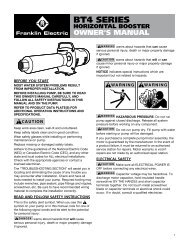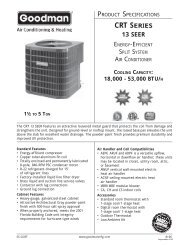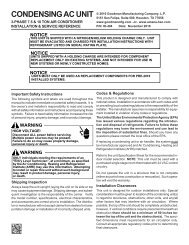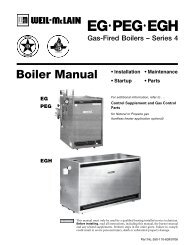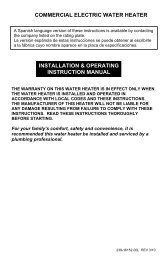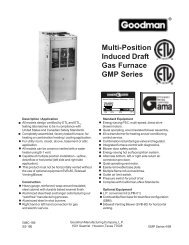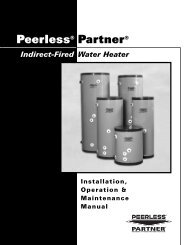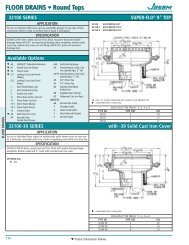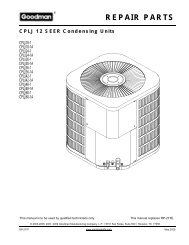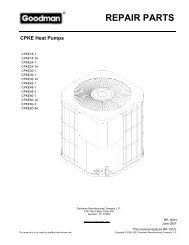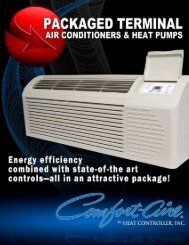7.5 TON - 12.5 TON PACKAGE GAS SERIES CPG SERIES - Goodman
7.5 TON - 12.5 TON PACKAGE GAS SERIES CPG SERIES - Goodman
7.5 TON - 12.5 TON PACKAGE GAS SERIES CPG SERIES - Goodman
You also want an ePaper? Increase the reach of your titles
YUMPU automatically turns print PDFs into web optimized ePapers that Google loves.
10 3/16”<br />
26 ½”<br />
3 3/4” DIMPLES MARK DRILL LOCATIONS<br />
HIGH VOLTAGE ENTRANCE<br />
LOW VOLTAGE ENTRANCE<br />
LEAD THERMOSTAT<br />
Red R (24V)<br />
Green G (Fan)<br />
Yellow Y1 (High Cool)<br />
Purple Y2 (Low Cool)<br />
Blue Common (if req'd)<br />
White W1 (Heat)<br />
Brown W 2 (High Heat)<br />
<strong>CPG</strong> 090 THROUGH 300 (<strong>GAS</strong> HEAT)<br />
<strong>GAS</strong> SUPPLY PIPING<br />
WARNING<br />
ELECTRICAL ENTRANCE LOCATIONS<br />
Unit is equipped with a Low Voltage Terminal Block and has<br />
Single Point wiring to the contactor.<br />
LOW VOLTAGE CONTROL WIRING<br />
1. A 24V thermostat must be installed for unit operation.<br />
It may be purchased with the unit or field -supplied.<br />
Thermostats may be programmable or<br />
electromechanical as required.<br />
2. Locate thermostat or remote sensor in the conditioned<br />
space where it will sense average temperature. Do<br />
not locate the device where it may be directly exposed<br />
to supply air, sunlight or other sources of heat. Follow<br />
installation instructions packaged with the thermostat.<br />
3. Use #18 AWG wire for 24V control wiring runs not<br />
exceeding 75 feet. Use #16 AWG wire for 24V control<br />
wiring runs not exceeding 125 feet. Use #14 AWG<br />
wire for 24V control wiring runs not exceeding 200<br />
feet. Low voltage wiring may be National Electrical<br />
Code (NEC) Class 2 where permitted by local codes.<br />
4. Route thermostat wires from sub-base terminals to<br />
the unit. Control wiring should enter through the duct<br />
panel (dimple marks entrance location). Connect<br />
thermostat and any accessory wiring to low voltage<br />
terminal block TB1 in the main control box.<br />
NOTE: Field-supplied conduit may need to be installed<br />
depending on unit/curb configuration. Use #18 AWG solid<br />
conductor wire whenever connecting thermostat wires to<br />
terminals on sub-base. DO NOT use larger than #18 AWG<br />
wire. A transition to #18 AWG wire may be required before<br />
entering thermostat sub-base.<br />
TO PREVENT PERSONAL INJURY OR DEATH DUE TO IMPROPER<br />
INSTALLATION, ADJUSTMENT, ALTERATION, SERVICE OR MAINTENANCE,<br />
REFER TO THIS MANUAL. FOR ADDITIONAL ASSISTANCE OR<br />
INFORMATION, CONSULT A QUALIFIED INSTALLER, SERVICE AGENCY OR<br />
THE <strong>GAS</strong> SUPPLIER.<br />
IMPORTANT NOTE: This unit is factory set to operate on<br />
natural gas at the altitudes shown on the rating plate.<br />
WARNING<br />
TO PREVENT PROPERTY DAMAGE, PERSONAL INJURY OR DEATH WHEN<br />
EITHER USING PROPANE <strong>GAS</strong> ALONE OR AT HIGHER ALTITUDES, OBTAIN<br />
AND INSTALL THE PROPER CONVERSION KIT(S). FAILURE TO DO SO CAN<br />
RESULT IN UNSATISFACTORY OPERATION AND/OR EQUIPMENT DAMAGE.<br />
HIGH ALTITUDE KITS ARE FOR U.S. INSTALLATIONS ONLY AND ARE NOT<br />
APPROVED FOR USE IN CANADA.<br />
The rating plate is stamped with the model number, type of<br />
gas and gas input rating. Make sure the unit is equipped to<br />
operate on the type of gas available. Conversion to propane<br />
(LP) gas is permitted with the use of the factory authorized<br />
conversion kit (see the unit Technical Manual for the appropriate<br />
kit). For High Altitude derates, refer to the latest edition<br />
of the National Fuel Gas Code NFPA 54/ANSI Z223.1.<br />
NATURAL<br />
PROPANE<br />
INLET <strong>GAS</strong> PRESSURE<br />
Min. 5.0" W.C., Max. 10.0" W.C.<br />
Min. 11.0" W.C., Max. 14.0" W.C.<br />
Inlet Gas Pressure Must Not Exceed the Maximum Value Shown in Table<br />
Above.<br />
The minimum supply pressure should not vary from that<br />
shown in the table above because this could prevent the unit<br />
from having dependable ignition. In addition, gas input to the<br />
burners must not exceed the rated input shown on the rating<br />
plate. Overfiring of the unit could result in premature heat<br />
exchanger failure.<br />
10<br />
PIPING<br />
IMPORTANT NOTE: To avoid possible unsatisfactory operation<br />
or equipment damage due to under firing of equipment,<br />
do not undersize the natural/propane gas piping from the<br />
meter/tank to the unit. When sizing a trunk line, include all<br />
appliances on that line that could be operated simultaneously.



